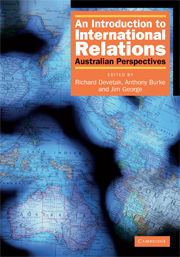Book contents
- Frontmatter
- Contents
- List of tables, figures and boxes
- List of contributors
- Preface and acknowledgments
- An introduction to international relations: the origins and changing agendas of a discipline
- 1 Theory and practice in Australian international relations: the search for identity and security
- Part 1 Theories of international relations
- 2 International relations theory in an era of critical diversity
- 3 Liberalism
- 4 Realism
- 5 Marxism
- 6 Feminism
- 7 Postmodernism
- 8 Constructivism and critical theory
- 9 Global justice and cosmopolitan democracy
- Part 2 The traditional agenda: states, war and law
- Part 3 The new agenda: globalisation and global governance
- Glossary of terms
- Bibliography
- Index
- References
4 - Realism
from Part 1 - Theories of international relations
- Frontmatter
- Contents
- List of tables, figures and boxes
- List of contributors
- Preface and acknowledgments
- An introduction to international relations: the origins and changing agendas of a discipline
- 1 Theory and practice in Australian international relations: the search for identity and security
- Part 1 Theories of international relations
- 2 International relations theory in an era of critical diversity
- 3 Liberalism
- 4 Realism
- 5 Marxism
- 6 Feminism
- 7 Postmodernism
- 8 Constructivism and critical theory
- 9 Global justice and cosmopolitan democracy
- Part 2 The traditional agenda: states, war and law
- Part 3 The new agenda: globalisation and global governance
- Glossary of terms
- Bibliography
- Index
- References
Summary
Introduction
In this chapter we explore three questions. First, what do those who call themselves realists in the study of international relations have in common? In answering this question it is important to consider both what unites realists as a group as well as the divisions between them. We distinguish between classical realism and neorealism, and draw attention to the contemporary debate between offensive neorealists and defensive neorealists over the degree to which the absence of international government constrains opportunities for cooperation among states. Second, what is the status of this particular ‘approach’ to the study of international relations? Is it a paradigm, or is it better understood more simply as a profoundly sceptical perspective towards any kind of purposive approach to world order? Third, what is the future of realism? If, as we argue, it no longer dominates the theoretical study of international relations as it did for most of the Cold War period, is it destined to pass away in the face of changes that appear to falsify realist premises and assumptions? Our argument, briefly stated, is that realism will endure. Indeed, in the wake of the United States' invasion of Iraq in 2003, contemporary realists are playing a key role in the debate over the future of American foreign policy in global politics, just as their predecessors did at the end of World War II.
The world according to realism
Realism is a general approach to international politics, not a single theory.
- Type
- Chapter
- Information
- An Introduction to International RelationsAustralian Perspectives, pp. 54 - 63Publisher: Cambridge University PressPrint publication year: 2007

